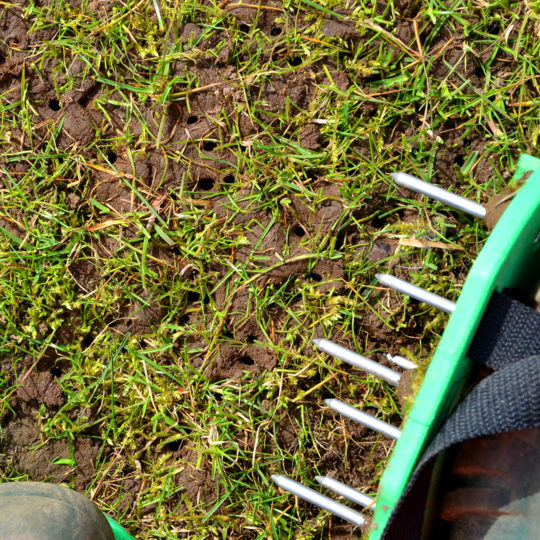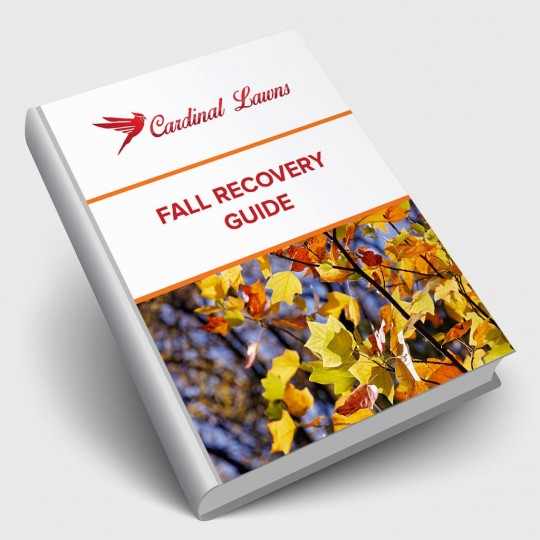Why You Should Aerate in the Fall
And How to do it Properly
Posted
October 12, 2023

Does your lawn need space to breathe? Heavy summer traffic and excessive thatch could have compacted and suffocated your soil, limiting access to essential water, air, and nutrients. You can help reopen these pathways this season with a simple process. Learn why you should aerate in the fall and what’s involved.
What is Aeration?
Basically, aerating is the process of perforating the soil to allow air, water, and nutrients to reach grass roots. Not only does this promote deeper root growth, but it also helps reinvigorate the lawn which can help prevent a range of problems such as pests and disease.
If you’re not sure whether to aerate your lawn this year, here are a few signs you should:
- Dried out and spongy feel. If your lawn feels hard and dry or lighter under foot, you may be dealing with too much thatch. Test a patch of lawn by cutting out a slice a few inches deep. If you notice a layer of dead or dried grass about an inch thick or more it’s time to aerate.
- New construction. Whether your home is new or you recently added an addition, topsoil may be buried or compacted from heavy equipment use.
- Pooling water. If water collects in certain areas of your lawn instead of quickly absorbing into the soil, it may be compacted. Between children and pets playing in the yard to extensive gardening, heavy foot traffic leads to soil compaction.
- It started as sod. If sod was used throughout your lawn, there may be layers of compacted soil preventing proper drainage.
Aerating breaks up the compacted soil and layers of thatch to open pathways for air, water, and nutrients to flow.
Why You Should Aerate in the Fall
The best time to aerate is while the grass is still growing. This helps it heal and naturally fill in the perforated holes. Spring and fall are the two seasons when grass is growing at its best. During winter and summer, grass goes dormant to help protect itself from harsh weather.
If you’re growing cool season grass, it’s best to aerate in the early spring or fall. This type of grass thrives in cooler weather, so the more temperate seasons are an ideal time to help keep it healthy. However, if you have a lawn with warm season grass, plan on aerating in the late spring when the weather is warmer.
Since the summer is one time of year soil can become extra compacted with festive foot traffic, fall is an ideal time to help it recuperate before going dormant in the winter. This way it can bounce back beautifully in the spring.
Timing Other Lawn Tasks
The right time to aerate also depends on the other lawn task you have on your list.
- Mowing or establishing sod. Since the foot traffic and equipment used in mowing your lawn and laying sod can both contribute to soil compaction, it’s best to aerate after these tasks to help loosen the soil.
- Weed control. Aerate your lawn before applying any products. This way you don’t disrupt the barrier you create over the soil.
- Overseeding. Since aerating helps create a direct pathway through the soil, it’s best to seed directly after aerating. This increases the chances of the seeds germinating.
- Fertilizing. Like grass seeds, nutrient-rich fertilizer will have a greater impact when it can reach roots deep in the soil. Aerate before to create these direct pathways.
- Watering. Since one of the purposes of aerating is to help the soil absorb more water, it’s best to water newly aerated soil within a day or two. Especially after you’ve seeded and fertilized as well. Watering regularly also helps the holes heal.
Aerating Tools and Tips
The tools you use for aerating are just as important as the timing. There are several options to choose from and each has their benefits.
- Spike Aerator. Features a single, solid tine, or fork, to simply spike holes into the ground. While it technically opens up a pathway for air circulation, it can also lead to compacted soil around the hole itself.
- Plug Aerator. Also known as core aerators, these tools perforate the soil but leave a plug, or core, behind. You should leave this core in the grass to break down again and return nutrients to the soil. These plugs can also be broken up the next time you mow.
These tools are typically available to rent at your local lawn and garden store. However, depending on the size of your lawn, it may be more beneficial to hire a professional lawn care service to do the work.
No matter what tool you choose, use these tips to help make the process easier:
- Focus on the areas where you have a lot of thatch or compacted soil.
- The soil should be moist before you aerate.
- Aerate in the morning when there’s more moisture in the grass.
- Multiple passes may be needed, especially in heavily compacted areas.
Aerate in the Fall with a Pro
If you’re still not sure if this is the right time to aerate or how to go about the process, contact Cardinal Lawns for help. Our lawn care experts will evaluate the type of grass you have and the current condition of your lawn to tell if it needs aerating. Even if you decide to aerate yourself, you’ll still need to rent the equipment. Why not save yourself the hassle and hire a pro who can get it done efficiently. Then all you have to do is continue to enjoy your lawn for seasons to come.

Download Your FREE Fall Recovery Guide
Summer’s extreme conditions can take a toll on your grass and its health. Take some time to learn how to bring your lawn back to life. This handy guide teaches you what needs to be done for a full fall recovery.